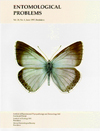Vol. 28, No. 1 - June 1997

| Entomological Problems Vol. 28, No. 1 - June 1997 |
 |
Contents
Víťaz Ľ., Bálint Zs. & Žitňan D.
Polyommatus slovacus sp. nov. (Lepidoptera, Lycaenidae):
the bivoltine relative of Polyommatus coridon in Slovakia
Jäch M. A. & Kodada J.
Prionosolus and Podonychus, two new genera of
Macronychini (Coleoptera: Elmidae)
Kubáň V.
Palaearctic and Oriental Coraebini (Coleoptera: Buprestidae) Part
IV
Pelletier J.
Four new species of Dactylotus from Xinjiang, China
(Coleoptera: Curculionidae)
Růžička J.
A new species of Attaephilus from Turkey (Coleoptera:
Leiodidae: Cholevinae)
Schödl S.
Taxonomic studies on the genus Enochrus (Coleoptera:
Hydrophilidae)
Vršanský P.
Piniblattella gen. nov. - the most ancient genus of
the family Blattellidae (Blattodea) from the Lower Cretaceous of Siberia
Abstracts
Víťaz Ľ., Bálint Zs. & Žitňan D.
1997. Polyommatus slovacus sp. nov. (Lepidoptera, Lycaenidae): the bivoltine relative
of Polyommatus coridon in Slovakia. Entomol. Probl., 28 (1): 1-8.
During the field work in temperate grassy chalkhills on both sides of river Váh in the south-western
region of Slovakia we discovered a bivoltine polyommatine lycaenid previously considered as the
univoltine P. coridon (Poda).
Detailed studies of external characters,morphology of male and female genitalia, as well as biology
of all live stages showed that the double-brooded blue is a new species. Specific morphological
characters, bionomy and ecology of P. slovacus are described and compared with related species.

Jäch M. A. & Kodada J. 1997.
Prionosolus and Podonychus, two new genera of Macronychini
(Coleoptera: Elmidae). Entomol. Probl., 28 (1): 9-23.
Two new riffle beetle genera, Prionosolus gen. nov. and Podonychus gen. nov., and
four new species, Prionosolus venatorcapitis sp. nov. (type species of Prionosolus),
P. ciampori sp. nov., P. bobae sp. nov. and Podonychus sagittarius sp. nov.
(type species of Podonychus) are described from Southeast Asia. The new genera belong to
the Macronychini.

Kubáň V. 1997.
Palaearctic and Oriental Coraebini (Coleoptera: Buprestidae) Part IV.
Entomol. Probl. 28 (1): 25-50.
The forth part of a study on the Palaearctic and Oriental tribe Coraebini
Bedel is presented, covering the genera
Brachycoraebus Kerremans, 1903 and
Coraebus Gory & Laporte, 1839.
One Brachycoraebus species is reviewed, B. longicornis sp. nov. is described.
Seven Coraebus species are reviewed and new synonyms established: C. annamensis
Descarpentries & Villers, 1967
(= C. blankae Kubáň, 1995), C.
amplithorax (Fairmaire, 1889)
(= C. vrazi Obenberger, 1934).
C. niponicus var. amamianus
Kurosawa, 1953 is an infrasubspecific name and not a
primary homonym to C. amamianus Kurosawa, 1985.
The following Coraebus species are described: C. akiyamai sp. nov., C. chucki
sp. nov., C. femina sp. nov., C. gorkaianus sp. nov., C. hovorkai sp. nov.,
C. jendeki sp. nov., C. occidentalis sp. nov., C. pseudoblandus sp. nov.,
C. pseudopurpura sp. nov., C. sainvali sp. nov., C. sausai sp. nov.,
C. svaneki sp. nov., C. tubulosus sp. nov. Lectotypes for four species are designated.

Pelletier J. 1997.
Four new species of Dactylotus from Xinjiang, China (Coleoptera: Curculionidae).
Entomol. Probl. 28 (1): 51-56.
This paper deals with the description on four new species of Dactylotus close to D.
trivialis Faust or
D. globosus Gebler, but clearly distinguished
by male genitalia characters. Indeed, the aedeagus of Dactylotus
presents an unusual degree of complexity which appears decisive for identification. The four
described species, D. hiekei, D. dsungariensis, D. krausei, and D.
trivalioides are found in the western part of Xinjiang, namely the Borochoro Shan and Tian
Shan Mounts.

Růžička J. 1997.
A new species of Attaephilus from Turkey (Coleoptera: Leiodidae: Cholevinae).
Entomol. Probl. 28 (1): 57-59.
Attaephilus rydhi sp. nov. from southern Turkey is described, illustrated and compared with
related species A. paradoxus (Motschulsky, 1844),
A. arenarius (Hampe, 1852), A. punctipennis
Jeannel, 1936 and A. weiratheri
Jeannel, 1936.

Schödl S. 1997.
Taxonomic studies on the genus Enochrus (Coleoptera: Hydrophilidae).
Entomol. Probl. 28 (1): 61-66.
Enochrus (Lumetus) hamifer (Ganglbauer
, 1901) (= E. caspius sensu auct.; nec Kuwert
, 1888) and Enochrus (Methydrus) nigritus (
Sharp,1872) are re-established as distinct species. The taxonomy of both species is discussed
in detail and distribution data are given. The following new synonymy is established: E.
(Methydrus) nigritus (Sharp)
(= E. (M.) isotae
Hebauer syn.n.). The synonymy of E.
(L.) caspius (Kuwert) (ex.p.)
with Enochrus (L.) fuscipennis (Thomson
) is proposed. Lectotypes are designated for Philhydrus nigritus
Sharp and Philhydrus hamifer
Ganglbauer.

Vršanský P. 1997.
Piniblattella gen. nov. - the most ancient genus of the family Blattellidae
(Blattodea) from the Lower Cretaceous of Siberia. Entomol. Probl. 28 (1): 67-79.
Piniblattella gen. nov. from the pre-Barremian Lower Cretaceous of Baissa (East Siberia) is
established and three new species are described: P. minuta sp. nov. and P. elegans sp.
nov. from Baissa, and P. altera sp. nov. found also in Bon Tsagaan (Central Mongolia).
Piniblattellini trib. nov. is proposed to accommodate the genus within the family Blattellidae and
subfamily Blattellinae. Morphological characters of the genus Piniblattella suggest, that it is the
most ancient and least advanced Blattellid. Its diversity indicates that the family
Blattellidae originated early in the Berriasian or in the late Jurassic period. Mesoblattina
vitimica Vishniakova is transferred to
Piniblattella and designated as the type species. Six nymphal instars are identified for
P. vitimica, and the reconstruction of adult is provided, including the description of male
and female terminalia. Its ontogeny appears similar to that of recent Blattellidae. The total number
of veinlets reaching the wing margin was found to be the most stable character of wing venation,
with the coefficient of variation being as low as 4.0. Ecology of the species is discussed.
Distribution of the fossils through the Baissa section indicates different temperature preferences
of the species described, and confirms short-time temperature oscillations.
